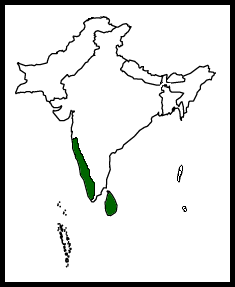- Aerodramus unicolor
Identification
A medium sized Swiftlet (12cm)
- Dark brown upperparts
- Marginally paler rump
- Pale brown underparts
- Shallow tail-fork
- Adults with slightly bronzy gloss on dark-tipped wings and tail
- Juveniles paler
Similar Species
Confusion possible with Dusky Crag Martin. Very similar to Himalayan Swiftlet, but ranges don't overlap.
Distribution
| Sri Lanka and Western Ghats in India. Locally common or very common, especially in Sri Lanka. Some local populations affected by nest harvesting. | |
| Legend |
Taxonomy
Monotypic. Slight differences between birds of Sri Lanka and birds of India are known, but no subspecies are described yet.
Also placed in genus Collocalia. Has been treated as conspecific with Himalayan Swiftlet Aerodramus brevirostris and/or Edible-nest Swiftlet Aerodramus fuciphagus. Aerodramus brevirostris rogersi has been placed in this species as well. The relationships in this group are still poorly understood.
Habitat
In India found from sea-level up to the mountains of the Western Ghats. In Sri Lanka more an upland species.
Behaviour
Forages high in small mixed flocks on various insects. Also seen feeding around lights at night.
Breeds in sometimes large colonies in caves, sometimes railway tunnels and also sea-caves. Leaves the colonies at dawn, returning at dusk.
Breeds mainly from March to June. Two eggs are laid. The nest is a white, shiny half-cup, constructed with thick saliva, containing plant parts and feathers. The (tasteless) nests are harvested and eaten as soup.
Resident. Some birds recorded in winter to the Maldives may belong to this species.
References
- Rasmussen, P.C. and Anderton, J.C. 2005. Birds of South Asia. The Ripley Guide. Washington D.C. and Barcelona: Smithsonian Institution and Lynx Editions. ISBN 84-87334-67-9
- Grimmett, R., Inskipp, C. and Inskipp, T. 1998. Birds of the Indian Subcontinent. London: Christopher Helm. ISBN 0-7136-4004-9
- Kazmierczak, K. and van Perlo, B. 2000. A Field Guide to the Birds of the Indian Subcontinent. London: Pica Press. ISBN 0-300-07921-4
- Kazmierczak, K. and Singh, R. 2001: A Birdwatcher's Guide to India. New Dehli: Oxford University Press. ISBN 019-565285-1
- del Hoyo, J., Elliott, A. and Sargatal, J. eds. 1999. Handbook of the Birds of the World. Vol. 5. Barn-owls to Hummingbirds. Barcelona: Lynx Edicions. ISBN 84-87334-22-9




